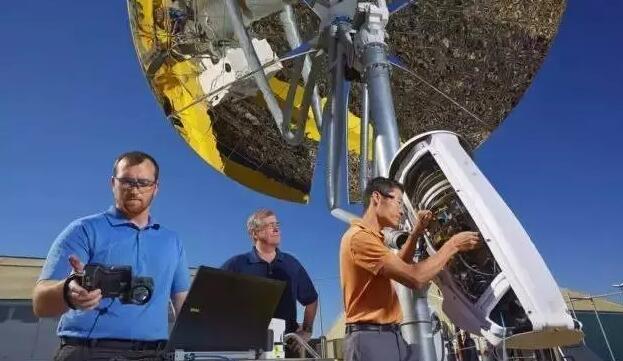
太平洋西北国家实验室(PNNL)从1990年以来就一直在研究用廉价的太阳能发电,同时制造廉价的氢燃料。还有两年时间,他们就可使氢燃料电池车在经济上变得更可行和划算。为实现这一目标,这个项目已经走过了20多年的历程,也曾被一度包括在火星计划之中。
研究人员一直在努力,把标准的太阳能电池板换成效率更高的太阳能反射器为基础的发电系统。该想法是使用太阳能反射器发电,用电能再把天然气转化成氢燃料,作为车辆的动力。
一个典型的太阳能电池板把阳光转换成电能的效率约为20%,而实验中的太阳能反射器可以达到70%的转化效率。负责该项目PNNL的工程师鲍勃说,作为对比,植物的光合作用(将太阳光转化为能量)的效率,只有不到10%。
为什么是氢燃料呢?每千克氢(2.2磅)和每加仑汽油(6.3磅)的能量大约相同。据联邦政府调查和不同汽车制造商的估计,每公斤氢气可使燃料电池汽车行驶大约50至81英里。
我们的项目已经非常接近商用化了
PNNL现在正在开发太阳能反射系统发电系统,并使用这种方式制造氢燃料,目标成本每公斤 $2美元。这大大低于当前的任何制造氢气的成本。2015年联邦政府的估计,从加氢站得到的氢燃料约为每公斤$13.50,而丰田官方把加氢站氢气的价格设定在每公斤$10至$12元。
“我们的项目已经非常接近商用化了”鲍勃说
自1990年代以来PNNL就一直致力于使用廉价太阳能发电制造燃料。在世纪之交,美国航空航天局的计划利用太阳光作为火星飞船的动力。这与西北太平洋国家实验
室的研究正好契合,于是该项目获得了巨大的推动力。虽然后来美国航空航天局的研究与PNNL的项目分道扬镳,但使用太阳能反射器技术以帮助制造更便宜的氢燃料的想法得以延续并继续发展迄今
“氢燃料汽车的出现令人眼花缭乱,同时也让人张目结舌。几十年来,燃料电池研发人员和汽车制造商永远只讲氢燃料是清洁能源,无需从化石燃料获得和也不产生尾气排放,是人类能源的未来和希望,但就是没有人告诉我们,氢气将来自哪儿和它的成本是什么“。
氢燃料汽车和为它们而创造的加氢站的经济性迄今为止仍然是个谜,也可以说是个未知的领域。大约两个星期前,美国能源部发布了公众意见的调查表,从此我们终于有机会了解和分析氢燃料,氢能汽车和加氢站的经济性和真相。
理论上,理想的情况下,氢车辆的燃料会比汽油便宜,并且基本上无污染。可是氢能汽车的一大主要的缺点 -这一技术仍然,处在实验阶段 - 氢燃料,氢动力汽车,加氢站都是非常昂贵的奢侈品。
在美国街头 我们已经可以看到两款氢燃料电池汽车的身影- 2015年款现代途胜和2016年款的丰田未来。它们的价格是$ 58,000到$ 60,000范围。第三个款式是2017年款的本田清晰,它目前的标价是$ 60,000美元。
为燃料电池汽车加氢的加氢站,目前还是稀少和罕见的。- 全球的加氢站一半儿在美国加州,欧洲和日本加在一起只有少数几个。2016年7月美国加州空气资源委员会的报告说,可以为20辆燃料电池汽车加氢气的加氢站,预计今年年底将增长到38,主要是在南加州的洛杉矶地区。
虽然即使汽车燃烧氢燃料也无污染,但在创造氢燃料的过程中,目前的工艺会产生自身的温室气体。这是西北太平洋国家实验室的项目评估最不理想的情况。
综上所述,PNNL太阳能反射器发电系统,每天能够产生15至17公斤的氢燃料。我们的想法是,在需要氢气的现场,部署数以千计的这种装置现场发电制氢。
The Pacific Northwest National Laboratory says it’s about two years away from making hydrogen fuel cell cars more cost-effective — a 20-plus-year journey that once included a dream of going to Mars.
Researchers at the lab in, have been working on a solar-reflector-based power source that they say is dramatically more efficient at generating electricity than a standard solar panel. The idea is to use the
solar-reflector device to provide the power to convert natural gas into hydrogen fuel for vehicles.
A typical solar panel converts sunlight into electricity at a 20 percent efficiency rate, while the experimental solar-reflector device can reach a 70 percent efficiency rate, said Bob Wegeng, the engineer in charge of the PNNL project. As a comparison, photosynthesis in plants converts sunlight into energy at an efficiency rate of slightly less than 10 percent.
Why hydrogen? A kilogram of hydrogen (2.2 pounds) has about the same energy content as a gallon of gasoline (6.3 pounds). A hydrogen-fuel-cell car gets roughly 50 to 81 miles per kilogram, according to various estimates from the federal government and auto manufacturers.
We’re very close to a project that is commercial
With most of the solar-reflection power source completed, PNNL is now
working on the engineering to use that power to create hydrogen fuel at a target cost of $2 per kilogram. That’s dramatically cheaper than the current conversion cost. A
<http://www.hybridcars.com/pros-and-cons-of-hydrogen-fuel-cell-vehicles/>
2015 story from HybridCars.com cited a federal estimate of $13.50 per
kilogram from a filling station dispensing hydrogen fuel. The same story quoted a Toyota official as putting the filling-station price at $10 to $12 per kilogram.
“We’re very close to a project that is commercial,” Wegeng said.
PNNL has been working at using cheap solar power to create fuels since the 1990s. At the turn of the century, that project received a tremendous boost when PNNL’s research meshed with NASA’s plans to use sunlight as a power source for Mars-bound spaceships. NASA’s research later diverged from PNNL project. But the idea of using solar-reflector technology to help create cheaper hydrogen fuel picked up momentum.
“Hydrogen cars have been such a tease. For decades, carmakers have held out the hope of clean energy, free of fossil fuels and tailpipe emissions, without telling us where the hydrogen will come from and what it will cost,” according to
<http://spectrum.ieee.org/transportation/advanced-cars/2016s-top-ten-tech-ca
rs-hyundai-tucson-fuel-cell> a story in IEEE Spectrum.
The economics of hydrogen-fueled cars and creating filling stations for them is still mostly uncharted territory. About two weeks ago, the U.S. Department of Energy
<http://energy.gov/eere/fuelcells/articles/doe-issues-request-information-hy
drogen-infrastructure-rdd> issued a request for public feedback so itcan begin to analyze the economics of hydrogen filling stations.
The theoretical upsides to hydrogen vehicles are that the fuel could be cheaper than gasoline, and essentially pollution-free. A major downside —besides still being in the experimental stage — is that hydrogen-powered cars are very expensive.
The hydrogen-powered Toyota Mirai
Two models are on American streets — the hydrogen-fueled version of the 2015 Hyundai Tucson and the 2016 Toyota Mirai. Their prices are in the range of $58,000 to $60,000. A third model is the 2017 hydrogen-fueled Honda Clarity, which carries a $60,000 price tag.
Today, hydrogen-fueled cars and the filling stations that provide hydrogen fuel are rare — essentially limited to the southern half of California in the United States along with small numbers in Europe and Japan.
<http://www.arb.ca.gov/msprog/zevprog/ab8/ab8_report_2016.pdf>A July 2016 California Air Resources Board report said there are 20 hydrogen vehicles refueling stations in that state, with that number expected to grow to 38 by the end of this year, mostly in the Los Angeles area.
Although burning hydrogen fuel in automobiles is pollution-free, the
current processes for creating hydrogen fuel produce their own greenhouse gases. That’s the downside that would be eliminated by the PNNL project.
The PNNL solar-reflector system would power a production device capable of creating 15 to 17 kilograms of hydrogen fuel per day. The idea is that hundreds, possibly thousands, of such devices could be installed at a fuel production site.





